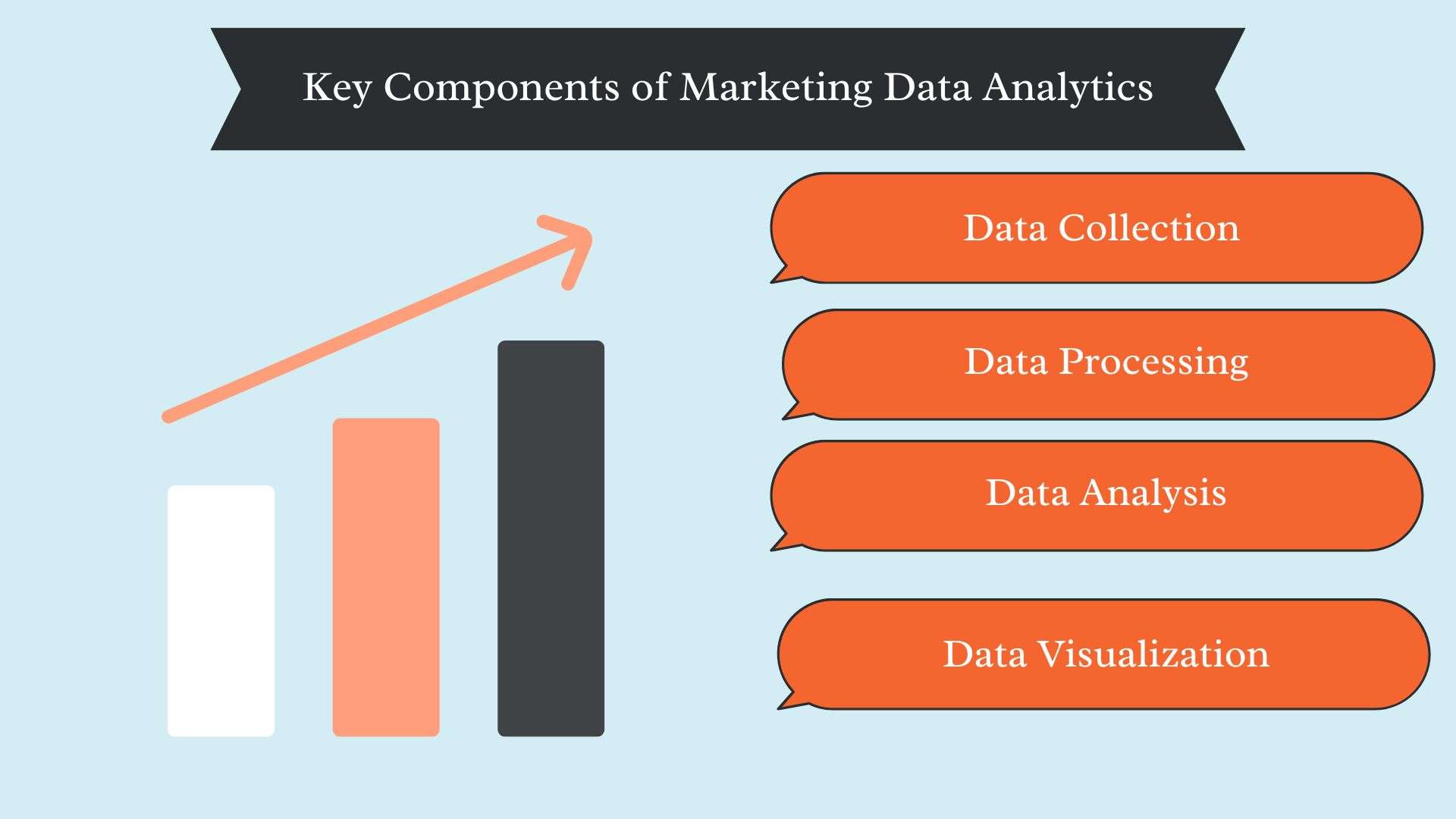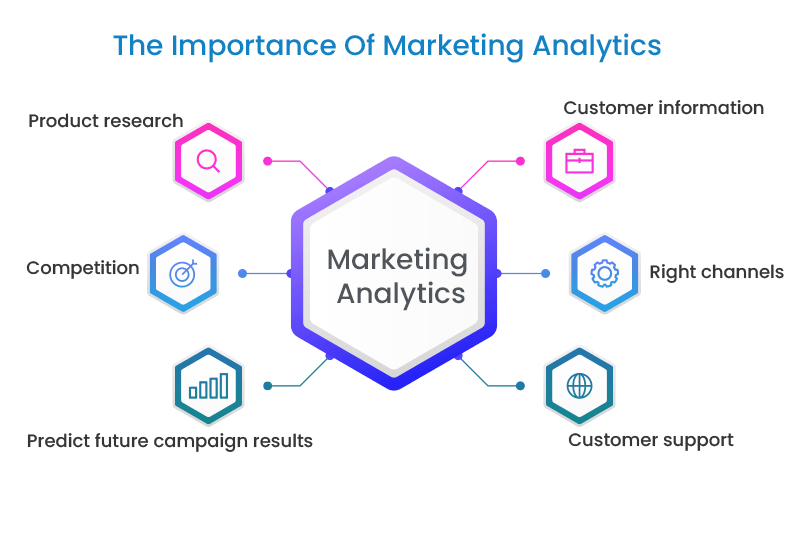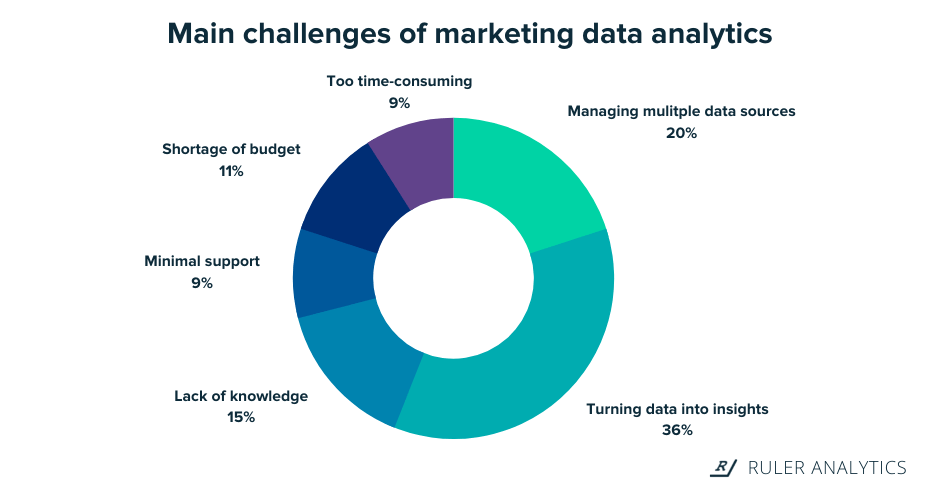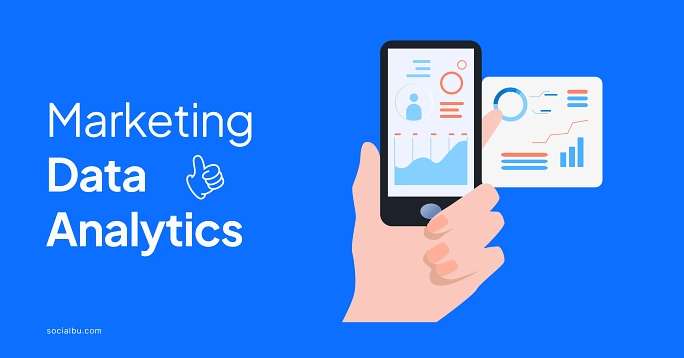Do you ever feel like you’re throwing money at marketing campaigns without knowing if they’re working? That’s a recipe for disaster, but with marketing data analytics, you can transform this guesswork into strategic brilliance.
By leveraging data, marketing data analytics empowers you to take control and understand precisely what’s working (and what’s not) in your campaigns. You’ll gain deep customer insights, optimize your marketing spend, and ultimately, get results from your marketing efforts.
So, are you ready to ditch the guesswork and step into data-driven marketing? This blog will break down everything you need to know about marketing data analytics, from what it is to how to use it effectively.
What is Marketing Data Analytics?

Marketing data analytics measures, manages, and analyzes marketing performance to maximize its effectiveness and optimize return on investment (ROI). It involves collecting, processing, analyzing, and interpreting data related to marketing activities. By using marketing data analytics tools, businesses can make informed decisions that enhance their marketing strategies and drive growth.
Key Components of Marketing Data Analytics

To fully understand marketing data analytics, it’s essential to break it down into its key components:
1. Data Collection
Data collection is the first step. It involves gathering raw data from various sources such as social media platforms, email campaigns, websites, and customer feedback forms. The goal is to obtain accurate and relevant data that can provide meaningful insights.
2. Data Processing
Once collected, the data needs to be processed. This step involves cleaning the data, removing inconsistencies, and organizing it in a structured format. Proper data processing ensures that the data is ready for analysis.
3. Data Analysis
Data analysis is the core of marketing data analytics. It involves examining the processed data to uncover patterns, trends, and insights. There are different types of data analysis, including descriptive, diagnostic, predictive, and prescriptive analytics. Each type serves a unique purpose and helps understand different aspects of marketing performance.
4. Data Visualization
Data visualization is about presenting data in a visual format, such as charts, graphs, and dashboards. It makes complex data more accessible and easier to understand. Effective data visualization helps stakeholders quickly grasp insights and make informed decisions.
Types of Marketing Data
Different types of data provide various insights into customer behavior and marketing effectiveness. Here are the main categories:
1. Demographic Data
Demographic data includes information about your audience’s characteristics, such as age, gender, income, education level, and location. This data helps you understand your customers and tailor your marketing efforts accordingly.
2. Behavioral Data
Behavioral data tracks customers’ and prospects’ actions, including website visits, social media interactions, email opens, and purchase history. Analyzing behavioral data helps you understand how customers interact with your brand.
3. Transactional Data
Transactional data refers to data generated from transactions, such as sales and purchases. This data provides insights into what customers buy, how often, and how much they spend. It is crucial to evaluate the financial performance of marketing campaigns.
4. Psychographic Data
Psychographic data studies your audience’s attitudes, values, interests, and lifestyles. This type of data helps create more personalized and engaging marketing messages by understanding the motivations behind customer behavior.
Marketing data analytics is a comprehensive process that involves collecting, processing, analyzing, and visualizing data. By leveraging the right components and understanding the different types of marketing data, businesses can make data-driven decisions that enhance their marketing strategies and drive success.
The Importance of Marketing Data Analytics
Understanding the importance of marketing data analytics is crucial for modern businesses. Harnessing the power of data can transform your marketing strategies, making them more effective and efficient.

Source: deetaanalytics.com
1. Data-Driven Decision Making
Marketing data analytics is essential for data-driven decision-making. Businesses can identify patterns and trends that inform their strategies by analyzing data. For example, if data shows that a particular marketing campaign led to a significant increase in sales, you can replicate similar strategies in the future. This approach minimizes guesswork and ensures that decisions are backed by solid evidence.
2. Improved Customer Understanding
One of the most significant benefits of marketing data analytics is improved customer understanding. Businesses can gain insights into customers’ preferences, behaviors, and needs by analyzing demographic, behavioral, and psychographic data. This understanding allows companies to tailor their marketing efforts to meet customer expectations better, resulting in higher engagement and satisfaction.
3. Enhanced Marketing ROI
Marketing data analytics helps in enhancing marketing ROI. Businesses can allocate their resources more effectively by tracking the performance of different marketing channels and campaigns. For instance, if data shows that social media ads generate more leads than email campaigns, you can focus more on social media marketing. This optimization leads to better use of marketing budgets and higher returns on investment.
4. Competitive Advantage
In today’s competitive market, staying ahead of the competition is crucial. Marketing data analytics provides a significant competitive advantage. By continuously monitoring and analyzing market trends and consumer behavior, businesses can quickly adapt to changes and seize new opportunities. This proactive approach helps maintain a strong market position.
5. Personalization Opportunities
Personalization is a critical trend in modern marketing, and data analytics makes it possible. Businesses can create personalized marketing messages and offers that resonate with individual customers by leveraging data.
For instance, if data shows that a customer frequently buys a particular type of product, you can send them personalized recommendations and discounts related to that product. Personalization enhances the customer experience and increases the likelihood of repeat purchases.
The importance of data analytics in marketing cannot be overstated. It is the key to unlocking valuable insights and driving growth.
Essential Tools and Technologies in Marketing Data Analytics
Marketing data analytics relies heavily on the right tools and technologies to gather, process, and analyze data effectively. These embedded analytics tools enable businesses to make informed decisions and optimize their marketing strategies.

1. Customer Relationship Management (CRM) Systems
CRM systems are critical for managing customer interactions and data. They store comprehensive customer information, including their behavior, preferences, and purchase history. This data is invaluable for creating targeted and personalized marketing campaigns.
Well-known CRM systems like Salesforce and Zoho CRM offer robust features that help businesses keep track of customer interactions and analyze data to improve customer relationships.
2. Google Analytics and Other Web Analytics Tools
Web analytics tools, particularly Google Analytics, are essential for understanding website performance. They track key metrics such as page views, bounce, and conversion rates. This data helps businesses understand how visitors interact with their websites and identify areas for improvement.
Google Analytics is widely used due to its comprehensive features and user-friendly interface, making it a staple in marketing data analytics.
3. Social Media Analytics Platforms
Social media analytics platforms collect and analyze data from social media channels. They track engagement metrics like likes, shares, comments, and overall reach. This information is crucial for measuring the effectiveness of social media campaigns and understanding audience preferences. Tools like SocialBu provide valuable insights that help businesses fine-tune their social media strategies.
4. Marketing Automation Software
Marketing automation software streamlines repetitive marketing tasks and workflows. It automates email marketing, social media posting, and lead nurturing processes. This software also tracks customer interactions, providing data that can be analyzed to improve marketing efforts.
Popular marketing automation tools like Mailchimp and Marketo offer features for automating marketing activities and analyzing data to enhance campaign performance.
5. Business Intelligence Tools
Business intelligence (BI) tools help businesses analyze large volumes of data and generate actionable insights. These tools offer advanced analytics capabilities, including data visualization, reporting, and predictive analytics. Embedded BI tools like Tableau and Microsoft Power BI are widely used for their powerful features that help businesses make data-driven decisions and optimize their marketing strategies.
Various tools and technologies play an important role in marketing data analytics, which is essential for gathering, processing, and analyzing data.
How to Use Marketing Data Analytics
Effectively utilizing marketing data analytics can significantly improve your marketing strategies. Here are the steps to harness the power of data analytics in your marketing efforts.
1. Setting Clear Objectives and KPIs
The first step in marketing data analytics is to set clear objectives and key performance indicators (KPIs). Objectives provide direction, while KPIs allow you to measure progress.
For example, if your objective is to increase website traffic, your KPIs include the number of unique visitors, page views, and bounce rates. Clear objectives and KPIs ensure that your marketing efforts are focused and measurable.
2. Collecting and Integrating Data from Multiple Sources
Collecting data from multiple sources is crucial for comprehensive analysis. This includes data from your website, social media platforms, email campaigns, and customer feedback.
Integrating data from these diverse sources provides a holistic view of your marketing performance. Tools like data management platforms (DMPs) can help collect and integrate data efficiently.
3. Analyzing Data to Derive Insights
After collecting and integrating data, the next step is to analyze it to derive actionable insights. There are four main types of data analysis:
Descriptive Analytics
Descriptive analytics focuses on understanding what has happened. It involves analyzing historical data to identify trends and patterns, providing a snapshot of past performance.
Diagnostic Analytics
Diagnostic analytics aims to understand why something happened. It delves deeper into the data to identify the causes behind trends and patterns. This analysis helps diagnose issues and understand the factors influencing performance.
Predictive Analytics
Predictive analytics uses historical data to forecast future outcomes. It uses statistical models and machine learning algorithms to predict future trends and behaviors. This type of analysis helps in making informed decisions about future marketing strategies.
Prescriptive Analytics
Prescriptive analytics goes a step further by recommending actions based on the analysis. It provides specific recommendations on what actions to take to achieve desired outcomes. This analysis helps optimize marketing strategies and improve performance.
4. Implementing Data-Driven Strategies
Once you have derived insights from your data, the next step is to implement data-driven strategies. This involves using the insights to inform your marketing decisions and actions.
For example, if data analysis shows that a particular social media platform generates high engagement, you might allocate more resources to that platform. Implementing data-driven strategies ensures that your marketing efforts are based on solid evidence and are more likely to succeed.
5. Monitoring and Adjusting Based on Results
Continuous monitoring and adjustment are essential for effective marketing data analytics. Regularly track your KPIs to assess the performance of your strategies. If the data shows that a particular strategy is not performing as expected, be prepared to make adjustments. This iterative process ensures that your marketing efforts remain effective and aligned with your objectives.
Effectively using marketing data analytics involves setting clear objectives and KPIs, collecting and integrating data from multiple sources, analyzing data to derive insights, implementing data-driven strategies, and continuously monitoring and adjusting based on results.
Best Practices for Marketing Data Analytics
Adhering to best practices in marketing data analytics ensures that your efforts are effective and yield reliable insights. Implementing these practices can significantly enhance your marketing strategies and overall business success.
1. Ensuring Data Quality and Accuracy
High-quality data is the foundation of effective marketing data analytics. Ensure that the data you collect is accurate, complete, and relevant. Regularly clean your data to remove any inaccuracies or duplicates.
Use reliable sources and tools to gather and validate data to maintain its integrity. High-quality data leads to more accurate insights and better decision-making.
2. Maintaining Data Privacy and Compliance
Protecting customer data is critical. Ensure your data collection and storage practices comply with data privacy regulations such as GDPR and CCPA. Implement robust security measures to protect data from breaches and unauthorized access. Implementing data privacy management solutions builds trust with your customers and prevents legal issues.
3. Fostering a Data-Driven Culture
Creating a data-driven culture within your organization is essential. Encourage all team members to rely on data for decision-making. Provide training and resources to help employees understand and use data effectively. A data-driven culture ensures everyone in the organization values and utilizes data to drive business success.
4. Continuous Learning and Skill Development
The field of marketing data analytics is constantly evolving. Stay updated with the latest trends, tools, and technologies. Invest in continuous learning and skill development for your team. Attend workshops, webinars, and courses to enhance your knowledge and skills. Keeping up with industry advancements ensures that your marketing data analytics efforts remain current and effective.
5. Balancing Automation with Human Insight
While automation tools can streamline data collection and analysis, human insight is still crucial. Use automation to handle repetitive tasks and process large volumes of data. However, rely on human expertise to interpret the data, derive meaningful insights, and make strategic decisions. Balancing automation with human insight leads to more accurate and actionable conclusions.
Challenges in Marketing Data Analytics
Despite its numerous benefits, marketing data analytics has its own set of challenges. Addressing these challenges is crucial for businesses to effectively leverage data analytics in their marketing strategies.

Source: ruler analytics
1. Data Silos and Integration Issues
One of the significant challenges in marketing data analytics is the presence of data silos. Data silos occur when data is isolated in different departments or systems, making it difficult to get a unified view of the data. Integrating data from multiple sources involves technical complexities and can be time-consuming.
Using data management platforms and ensuring cross-functional collaboration can help mitigate this issue and provide a holistic view of marketing data.
2. Skill Gap and Talent Shortage
There is a notable skill gap and talent shortage in marketing data analytics. Businesses often struggle to find professionals with the right mix of analytical skills and marketing knowledge. Investing in training and development programs for existing employees can help bridge this gap. Exploring Gamma alternatives can enhance these programs by quickly transforming complex data reports into clear, visually engaging presentations that improve learning and retention.
Additionally, partnering with educational institutions to create specialized courses can develop a pipeline of skilled professionals in marketing data analytics.
3. Keeping Up with Evolving Technologies
The rapid pace of technological advancement poses another challenge. New tools and technologies continually emerge, making it challenging for businesses to stay updated.
It is essential to regularly review and update your technology stack. Investing in continuous learning and staying informed about industry trends can help businesses keep up with evolving technologies and maintain a competitive edge.
4. Balancing Data Collection with User Privacy
Balancing data collection with user privacy is a critical concern. With increasing awareness and regulations around data privacy, businesses must ensure they collect data ethically and transparently. Complying with regulations like GDPR and CCPA is essential. Clear communication with customers about data collection practices and obtaining consent can build trust and ensure compliance.
Conclusion
Marketing data analytics is essential for modern businesses looking to optimize their marketing strategies and achieve tremendous success. Businesses can maintain a competitive edge by staying updated with the latest trends, such as advancements in AI and ML, real-time analytics, enhanced data privacy regulations, and the integration of AR and VR.
Embracing these trends and leveraging advanced analytics will enable businesses to make informed decisions and drive growth. Ready to transform your marketing efforts with powerful analytics tools? Try SocialBu today and take your marketing data analytics to the next level.
FAQs
1. What is marketing data analytics?
Marketing data analytics involves collecting, processing, and analyzing data to inform and optimize marketing strategies, ultimately improving decision-making and business outcomes.
2. What are the four stages of marketing analytics?
The four stages of marketing analytics are descriptive analytics (what happened), diagnostic analytics (why it happened), predictive analytics (what could happen), and prescriptive analytics (what should be done).
3. What is an example of marketing analytics?
An example of marketing analytics is tracking the performance of a social media campaign by analyzing metrics such as engagement rates, click-through rates, and conversions to measure its effectiveness.
4. What are marketing analytics tools?
Marketing analytics tools are software applications that help collect, process, and analyze marketing data, including platforms like Google Analytics, CRM systems, and social media analytics tools.
5. Is marketing analytics in demand?
Marketing analytics is in high demand as businesses rely on data-driven insights to optimize their marketing strategies and improve ROI.
6. Who uses marketing analytics?
Marketers, data analysts, business strategists, and decision-makers across various industries use marketing analytics to enhance marketing efforts and drive business growth.







